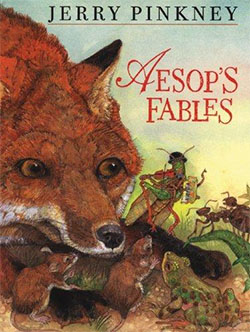Aesop's Fables (Pinkney book) facts for kids

First edition cover of Aesop's Fables
|
|
| Author | Aesop |
|---|---|
| Illustrator | Jerry Pinkney |
| Country | United States |
| Language | English |
| Genre | Children's literature, fable, picture book |
| Published | 2000 (SeaStar Books) |
| Media type | Print (hardback) |
| Pages | 87 |
| ISBN | 9781587170003 |
| OCLC | 43798267 |
Aesop's Fables is a special collection of 61 short stories called fables. These stories were retold by Jerry Pinkney in the year 2000. They feature many different animals, like wolves, foxes, lions, dogs, mice, and donkeys. Each story teaches a valuable lesson about life.
Contents
What Are Aesop's Fables?
Aesop's Fables are a group of ancient stories. They are known for teaching important moral lessons. These stories often use animals as characters. The animals act and speak like humans. They show us good and bad ways to behave.
Who Was Aesop?
Aesop was a storyteller from ancient Greece. People believe he lived around 620 to 564 BC. It's not clear if Aesop was a real person or just a legend. Some say he was a slave who was very wise. He used his stories to share his wisdom.
His fables were first told by word of mouth. Later, they were written down. Many different versions exist today. They have been translated into countless languages.
What Makes a Fable Special?
Fables are short stories. They usually have animal characters. These animals often have human qualities. They can talk, think, and feel. Each fable ends with a clear moral. This moral is a lesson about how to live. It might be about honesty, hard work, or kindness.
Fables are different from other stories. They don't just entertain. They also teach you something important. They help you understand right from wrong.
The Moral of the Story
The moral is the main point of a fable. It's the lesson you should learn. Sometimes, the moral is stated directly at the end. For example, "Slow and steady wins the race." Other times, you have to figure it out yourself. Fables help you think about consequences. They show how actions lead to outcomes.
Popular Fables You Might Know
Many of Aesop's fables are very famous. You might have heard some of them. They are still popular today. They are told in books, movies, and cartoons.
- The Tortoise and the Hare: This story teaches us that being slow and steady can win the race. Being fast and boastful doesn't always work out.
- The Ant and the Grasshopper: This fable is about planning for the future. The ant works hard, while the grasshopper plays. When winter comes, only the ant is ready.
- The Lion and the Mouse: This story shows that even small creatures can help big ones. A tiny mouse helps a mighty lion. It teaches us that kindness is important.
- The Fox and the Grapes: This fable is about pretending you don't want something you can't have. The fox can't reach the grapes, so he says they must be sour.
Why Are These Stories Still Important?
Aesop's fables have been around for thousands of years. They are still read and loved today. This is because their lessons are timeless. They teach universal truths. These truths apply to everyone, no matter where or when they live.
They help young people learn about good values. They encourage thinking about actions. They also spark imagination. The simple stories are easy to remember. Their lessons stay with you for a long time.
About This Book by Jerry Pinkney
The book Aesop's Fables published in 2000 is special. It was retold by Jerry Pinkney. He was a famous American illustrator and author. Pinkney was known for his beautiful artwork. His pictures bring the stories to life.
This collection includes 61 of Aesop's classic fables. Pinkney's retelling makes them fresh and exciting. His illustrations help readers connect with the animal characters. The book is a wonderful way to discover these ancient tales. It's a great example of how old stories can be made new.

